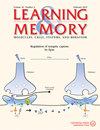解码弧转录:刺激模式和转录输出的活细胞研究
IF 1.8
4区 医学
Q4 NEUROSCIENCES
引用次数: 0
摘要
活动调节细胞骨架相关蛋白(Arc)在突触可塑性中扮演着至关重要的角色,而突触可塑性是学习和记忆过程中不可或缺的一个环节。Arc 在受到刺激后几分钟内就会被诱导转录,从而成为神经元活动的有用标记。然而,由于无法在活细胞中实时观察 mRNA 转录,启动 Arc 转录的特定神经元活动模式一直难以捉摸。我们利用基因编码 RNA 指示剂(GERI)小鼠模型(该模型表达标记有多个 GFP 的内源性 Arc mRNA),研究了 Arc 在各种电场刺激模式下的转录活动。GERI小鼠模型是由Arc-PBS基因敲入小鼠和表达融合了GFP的同源结合蛋白的转基因小鼠杂交产生的,Arc-PBS基因敲入小鼠在Arc mRNA的3′非翻译区(UTR)设计了结合位点。在离体的海马神经元中,我们发现刺激模式会显著影响 Arc 的转录。具体来说,由 10 赫兹频率的高频(100 赫兹)脉冲串组成的θ-脉冲串刺激诱导的 Arc 转录率最高。与此同时,核钙质瞬态的振幅也在 10 Hz 脉冲串刺激下达到峰值,这表明钙质浓度与转录之间存在相关性。然而,我们的双色单细胞成像显示,在 10 Hz 脉冲串刺激下,弧阳性神经元和弧阴性神经元的钙离子幅值没有显著差异,这表明弧转录的诱导还涉及其他因素。我们的活细胞 RNA 成像更深入地揭示了活动模式和钙信号通路对转录的复杂调控。本文章由计算机程序翻译,如有差异,请以英文原文为准。
Decoding Arc transcription: a live-cell study of stimulation patterns and transcriptional output
Activity-regulated cytoskeleton-associated protein (Arc) plays a crucial role in synaptic plasticity, a process integral to learning and memory. Arc transcription is induced within a few minutes of stimulation, making it a useful marker for neuronal activity. However, the specific neuronal activity patterns that initiate Arc transcription have remained elusive due to the inability to observe mRNA transcription in live cells in real time. Using a genetically encoded RNA indicator (GERI) mouse model that expresses endogenous Arc mRNA tagged with multiple GFPs, we investigated Arc transcriptional activity in response to various electrical field stimulation patterns. The GERI mouse model was generated by crossing the Arc-PBS knock-in mouse, engineered with binding sites in the 3′ untranslated region (UTR) of Arc mRNA, and the transgenic mouse expressing the cognate binding protein fused to GFP. In dissociated hippocampal neurons, we found that the pattern of stimulation significantly affects Arc transcription. Specifically, theta-burst stimulation consisting of high-frequency (100 Hz) bursts delivered at 10 Hz frequency induced the highest rate of Arc transcription. Concurrently, the amplitudes of nuclear calcium transients also reached their peak with 10 Hz burst stimulation, indicating a correlation between calcium concentration and transcription. However, our dual-color single-cell imaging revealed that there were no significant differences in calcium amplitudes between Arc-positive and Arc-negative neurons upon 10 Hz burst stimulation, suggesting the involvement of other factors in the induction of Arc transcription. Our live-cell RNA imaging provides a deeper insight into the complex regulation of transcription by activity patterns and calcium signaling pathways.
求助全文
通过发布文献求助,成功后即可免费获取论文全文。
去求助
来源期刊

Learning & memory
医学-神经科学
CiteScore
3.60
自引率
5.00%
发文量
45
审稿时长
6-12 weeks
期刊介绍:
The neurobiology of learning and memory is entering a new interdisciplinary era. Advances in neuropsychology have identified regions of brain tissue that are critical for certain types of function. Electrophysiological techniques have revealed behavioral correlates of neuronal activity. Studies of synaptic plasticity suggest that some mechanisms of memory formation may resemble those of neural development. And molecular approaches have identified genes with patterns of expression that influence behavior. It is clear that future progress depends on interdisciplinary investigations. The current literature of learning and memory is large but fragmented. Until now, there has been no single journal devoted to this area of study and no dominant journal that demands attention by serious workers in the area, regardless of specialty. Learning & Memory provides a forum for these investigations in the form of research papers and review articles.
 求助内容:
求助内容: 应助结果提醒方式:
应助结果提醒方式:


